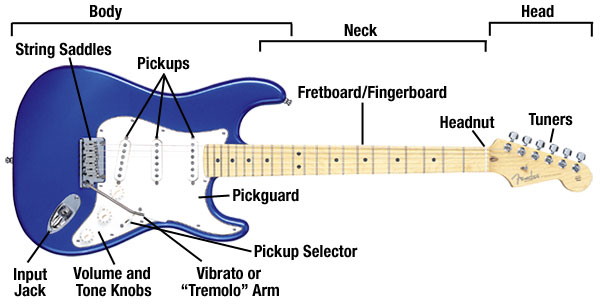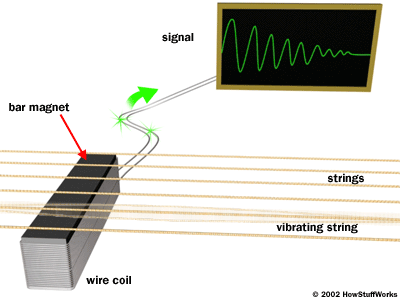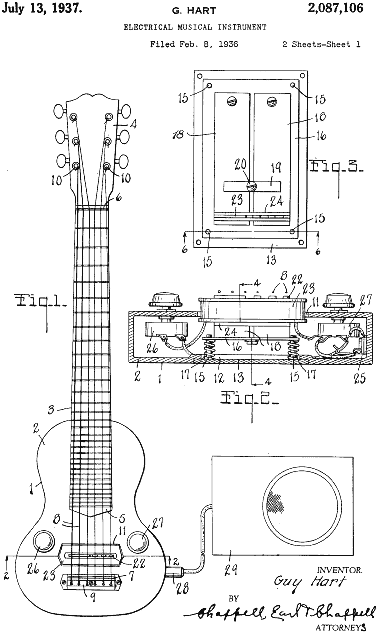How Electric Guitars Work
Despite the slow start, the electric guitar did find its place. It has inspired and defined entirely new types of music. The electric guitar remains the most prominent instrument in rock music, and the most famous instrument ever to come out of the United States.

From a popular culture standpoint, the electric guitar is one of the most important inventions of the 20th century. More than any other instrument, it defines the tone and character of rock and roll music. But when the electric guitar first hit the scene in the 1930s, few people saw its potential. It took quite a while for the instrument to find its place in American music.
Despite the slow start, the electric guitar did find its place. It has inspired and defined entirely new types of music. The electric guitar remains the most prominent instrument in rock music, and the most famous instrument ever to come out of the United States.
In this article, you will learn exactly how the guitar itself works, and we will also discuss the system that the guitar and the amp create together. Working in combination, the guitar and the amp can produce an amazing variety of sounds.
If you have ever compared an electric guitar to an acoustic guitar, you know that they have several important things in common. Both acoustic and electric guitars have six strings, they both tune those strings with tuning pegs and they both have frets on a long neck. Down at the body end is where the major differences are found.
Some electric guitars have a hollow or semi-hollow body with the resonating cavity found in an acoustic guitar, but the most popular electric guitars have solid bodies. The sound is produced by magnetic pickups and controlled by several knobs. If you pluck a string on an electric guitar that is not plugged in, the sound is barely audible. Without a soundboard and a hollow body, there is nothing to amplify the string's vibrations.
In the next section, we'll see how the magnetic pickups on an electric guitar sense vibration and turn it into sound.

To produce sound, an electric guitar senses the vibrations of the strings electronically and routes an electronic signal to an amplifier and speaker. The sensing occurs in a magnetic pickup mounted under the strings on the guitar's body. A simple magnetic pickup looks like this:
This pickup consists of a bar magnet wrapped with as many as 7,000 turns of fine wire. If you have read How Electromagnets Work, then you know that coils and magnets can turn electrical energy into motion. In the same way, they can turn motion into electrical energy. In the case of an electric guitar, the vibrating steel strings produce a corresponding vibration in the magnet's magnetic field and therefore a vibrating current in the coil.
There are many different types of pickups. For example, some pickups extend a single magnet bar under all six strings. Others have a separate polepiece for each string, like this:
.gif)
The upper variable resistor adjusts the tone. The resistor (typically 500 kilo-ohms max) and capacitor (0.02 microfarads) form a simple low-pass filter. The filter cuts out higher frequencies. By adjusting the resistor you control the frequencies that get cut out. The second resistor (typically 500 kilo-ohms max) controls the amplitude (volume) of the signal that reaches the jack. From the jack, the signal runs to an amplifier, which drives a speaker.
The body of this Gibson Gary Moore Signature electric guitar has multiple pickups.
Many electric guitars have two or three different pickups located at different points on the body. Each pickup will have a distinctive sound, and multiple pickups can be paired, either in-phase or out, to produce additional variations.
Next, we'll look at the role of the amplifier.
Most electric guitars are completely passive. That is, they consume no power, and you don't have to plug them into a power supply. (Some do have "active" electronics powered by an onboard battery.) The vibration of the strings produces a signal in the pickup coil. That bare, unamplified signal is what comes out of the guitar and into the amp.
The amp's job is to take the guitar's signal and make it audible by boosting it enough to drive a speaker. The fascinating thing about an electric guitar amp is that the amp is actually a part of the instrument.
The role of an electric guitar amp is completely different from the amplifier in a stereo system. A stereo amp is meant to be transparent -- its job is to reproduce and amplify sound with as little distortion as possible. With an electric guitar amp, musicians often seek distortion as well as the option of a "clean" sound. Distortion results when the signal in an amp's circuitry is too powerful for that circuitry. The distortion is actually a part of the desired sound, and many amps are designed so that guitarists can control the level of distortion.
Musicians may also take advantage of feedback loops between the amp and the guitar. If the sound coming out of the amp and speaker is loud enough, it can cause the guitar's strings to vibrate. The musician can hit a note with the guitar, and the amp will cause that string to continue vibrating indefinitely. Both of these concepts -- amp distortion and feedback -- are unique to the electric guitar.
A typical amp has at least three parts:
A pre-amp
A power amplifier
A speaker
Some amps also include effects and reverb circuits between the pre-amp and the power amplifier. The job of the pre-amp is to boost the guitar's signal enough so that it can actually drive the power amplifier stage. Because an electric guitar is passive, its signal does not have enough power to drive the power amp directly.

One of the interesting things about many electric guitar amplifiers is the use of vacuum tubes. Vacuum tubes have distortion patterns and characteristics that are known and loved by many musicians. These musicians seek out tube amps with specific tubes and specific amplifier circuits (for example, Class A versus Class AB amplifiers) to get the exact sound they are looking for.
In the next section, we'll review the history of the electric guitar.
-
How Electric Guitars Work
- Electric Guitar History
Engineers began experimenting with electrically powered instruments, such as music boxes and player pianos, in the 1800s. But the first attempts at an amplified instrument did not come until the development of electrical amplification by the radio industry in the 1920s.
One of the earliest innovators was Lloyd Loar, an engineer at Gibson Guitar Company. In 1924, Loar developed an electric pickup for the viola and the string bass. In Loar's pickup design, the strings passed vibrations through the bridge to the magnet and coil, which registered those vibrations and passed the electric signal on to an amplifier. The first commercially advertised electric guitar, made by the Stromberg-Voisinet company in 1928, utilized a similar pickup, with vibrations being picked up from the soundboard.

The goal of these early innovators was to amplify the natural sound of the guitar, but the signal was too weak. It was only when engineers utilized a more direct pickup system, in which the electromagnet registered string vibration from the strings themselves, that the modern electric guitar became a reality. The first commercially successful model, the so-called "Frying Pan," was developed and marketed by George Beauchamp and Adolph Rickenbacker in 1932.
In the 1950s and 1960s, rock stars secured Gibson and Paul's designs, as well as Fender's famous Stratocaster, a permanent place in American culture. Since then, every generation has found a surprising new way of making the instrument sing. By all accounts, its potential is limitless.
Valote
(collectibles: howstuffworks)